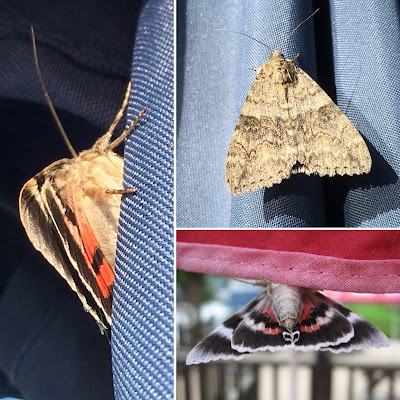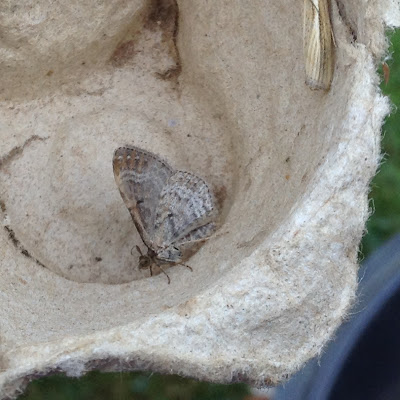Red Undwrings have visited the actual trap but they have a liking for sun umbrellas. The first I saw in this part of the world, back in August 2009 when we were down from Leeds for weekend, was on a pub umbrella at Radcot Bridge. It was spotted by Penny who was also struck by the toning of its pink underwing with the brewery's branding colour (bottom left, above).
The underwing is your best hope of a photo which explains why the moth has its name. It stubbornly refuses to show its bright scarlet top petticoat when at rest and you have to be very quick to snatch a photo of it if and when you irritate the moth into giving you a quick flash. I tickled this one three times, in the manner of my granddaughter enticing a moth on to her finger, and each time it flew away, circled the umbrella and then came back to roost in the folds of material again. Its final resting place was too high for me to reach, so I left it in peace and went back to my kipper.
Earlier in the morning I had found this strange moth on my pillow, one with markings unlike anything in the Moth Bible. I wondered if it was something foreign or an aberration but on close inspection, I think that the effect of being squashed by me - which sadly may be what happened if it had snuggled on to my pyjamas when I was inspecting the trap - produced what appears to be wing scale loss, more or less identical on each wing. So I think it was a Carpet moth of some kind, but a Carpet Hoovered clean.
The orange and yellow Sallow moths are a sign of Autumn in the offing and they have come a little early this year. Here are a couple of Centre-barred Sallows, one in the trap and the other dozing nearby. Two pictures also of one of my favourite small moths the Green Carpet, the top one from above and the bottom one from below, through the trap's transparent cowl on which it had found rest. I like it largely because green is not that common a colour in UK moths; so it's nice to follow the pictures with two of Light Emeralds, again one in the trap and the other close by, in our Romneyia poppy which has yet to give us any of its massive, floppy fried egg flowers this year because we didn't cut back its old wood last winter.
A quintet of grey and brown visitors here which I will identify for certain later because I need to go out and check this morning's trap shortly; but I am pretty sure that the top two are Flounced Rustics, bottom right a Square-spot Rustic, bottom middle a Lychnis and bottom left a White-point.
Next - sorry, I hope that I am not going on too long - here are two examples of that very multitudinous visitor the Mother of Pearl micro in an unusual resting position, showing the pointy forewing tips, photos which also illustrate how digital photography can change colours depending on the amount of light. Sadly this moth is in an unusual position because it has died although the lovely iridescence which gives the species its name is still evident. The photo bottom right shows a living example which was also in the trap, resting in the normal pose.
Three moths outside the trap now: the lovely, striking yellow of a Brimstone, a sleek Swallow Prominent and one I need to ID. And finally three Carpets pretending to be butterflies and, in solitary glory, a little Common Plume.





















































